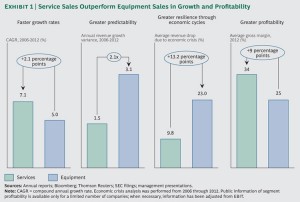by Victor Du, Kelly Howe, Rahul Jain, Rafael Rilo, Patrick Staudacher, Pekka Vanne, and Francisco Salmerón; May 06, 2014
Machinery companies come in forms as varied as the equipment they manufacture. Just as equipment prices range from thousands to millions of dollars, companies vary from large business conglomerates to highly specialized niche companies. What most have in common is that they generate substantial value from after-sales services.
There is no one strategy for machinery companies to generate value from services. The best way to create and maximize value varies according to equipment characteristics, competitive environment, and regulatory conditions. Some companies extract most of their service value from selling spare parts. Others focus on maintenance or diversify into the processes for which their machinery is used. Every day, machinery companies are extending their service portfolios with more innovative and customer-oriented offers.
Services as a Driver of Value Creation
Machinery companies, irrespective of sector, usually have significant service businesses, representing up to 50 percent of their total revenues. Such revenues are a reflection not only of the sector and installed base of the company but also the success of the services strategy.
An analysis of performance from leading machinery companies in recent years shows that services have outperformed equipment sales in several dimensions. (See Exhibit 1.)
- Faster Growth Rates. Most machinery companies have managed some positive growth in spite of the global economic crisis, but service sales pulled the most weight—averaging a compound annual growth rate (CAGR) that was more than two points higher than that of equipment sales.
- Greater Predictability. Equipment sales tended to fluctuate widely. They showed twice as much variance in CAGR as did service sales.
- Greater Resilience Through Economic Cycles. The success of machinery companies depends heavily on global economic conditions—and the recent economic crisis provided a significant test. Although equipment sales fell by 23 percent—measured from the last year before the drop in sales to the last year before the recovery—services sales fell by only 10 percent during that same period.
- Greater Profitability. Services are usually more profitable, too. Equipment sales in many industries generate low margins, particularly if the analysis factors in indirect costs such as commercial expenditures and product development. Service sales show higher margins, although there are variations among types of service. Spare-parts services have had, with some notorious exceptions, higher average margins than labor-related work. Analysis of public information shows services as more than 9 percentage points more profitable than equipment sales.
Because of this superior growth and profitability, machinery companies with a greater focus on services will typically outperform their peers. Analysis of leading machinery companies shows that those with a higher share of revenues from services generate a superior total shareholder return (TSR). (See Exhibit 2.)
Designing a Strategy to Maximize Service-Based Value Creation
There is no one-size-fits-all service strategy to suit every machinery company, but there are three broad models that cover how most can make money from services.
- A Strategy Focused on Spare Parts. With this model, companies extract most of their value from spare-parts sales, tailoring services and product offerings to capture the maximum number of spare parts throughout the life cycle of the equipment.
- A Strategy Focused on Maintenance. Industry value is concentrated in service contracts in this model, and companies aim to maximize the penetration rate and loyalty of customer contracts.
- Offering the Complete Process. In this model, suppliers expand beyond machinery servicing to cover whole processes in which their equipment plays a leading role. They can do this by using their specialized expertise to save costs for the customer.
Most machinery companies use a mix of these business models, offering a wide portfolio of services that includes spare parts, maintenance, and complete processes. It is typical, however, for one model to predominate and the others to fill in the missing pieces.
